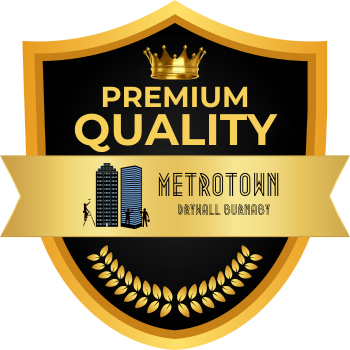Professional Bathroom Drywall Repair in Burnaby, BC
Bathrooms demand specialized drywall solutions that can withstand constant humidity, steam, and temperature changes. At Metrotown Drywall Burnaby, we deliver professional bathroom drywall repair and restoration services designed for lasting protection against moisture and mold. From replacing water-damaged panels to installing mold-resistant and waterproof finishes, our experts ensure your walls and ceilings stay strong and beautiful for years.
We use high-performance materials like green board and moisture-resistant compounds, combined with precise installation and sealing techniques, to protect your bathroom from future water damage. Whether you’re repairing a small patch, restoring an entire wall, or renovating your space for a modern, clean finish, our licensed contractors deliver reliable results tailored to Burnaby homes and businesses.
Call (604)-330-8736 today for a free consultation and discover how Metrotown Drywall Burnaby can restore and protect your bathroom drywall with durable, mold-resistant solutions.


Specialized Bathroom Drywall Repair Solutions in Burnaby
Bathroom environments require specialized drywall repair approaches due to constant moisture exposure and humidity challenges. Professional contractors use moisture-resistant materials, mold prevention techniques, waterproof installation methods, and green board solutions to ensure long-lasting repairs in wet conditions.
Moisture-Damaged Drywall Restoration
Moisture damage creates serious structural problems in bathroom walls and ceilings. Water infiltration weakens drywall integrity and leads to cracking, sagging, and material breakdown.
Professional drywall repair services begin with thorough moisture assessment using specialized detection equipment. Contractors identify the full extent of water penetration before starting restoration work.
The restoration process involves complete removal of compromised sections. Standard drywall cannot be salvaged once moisture has penetrated the material core.
Proper drying techniques eliminate residual moisture from wall cavities. Industrial dehumidifiers and fans ensure complete moisture removal before new installation begins.
Surface preparation includes treating underlying structures with antimicrobial solutions. This prevents future mold growth and extends repair longevity.
Mold-Resistant Drywall Options
Mold growth poses significant health risks in bathroom environments. Specialized drywall products provide enhanced protection against mold development in high-humidity areas.
Mold-resistant drywall features specially treated paper facing that prevents mold spore attachment. The gypsum core contains antimicrobial additives for additional protection.
These products cost approximately 20-30% more than standard drywall but offer superior long-term performance. The investment prevents costly future remediation projects.
Professional installation ensures proper sealing around fixtures and penetrations. Drywall contractors use mold-resistant joint compounds and primer systems for complete protection.
Regular maintenance extends the life of mold-resistant installations. Proper ventilation and humidity control maximize material performance.
Waterproof Drywall Repair Techniques
Waterproof installation methods protect bathroom walls from moisture infiltration. These techniques create barriers that prevent water damage and extend repair durability.
Vapor barriers installed behind new drywall block moisture transmission through wall assemblies. Plastic sheeting or specialized membrane products provide effective protection.
Waterproof sealants applied at all joints and penetrations eliminate potential leak points. Professional contractors use bathroom-grade sealants designed for wet environments.
Surface treatments include waterproof primers and specialized coating systems. These products create additional moisture protection on finished surfaces.
Installation techniques focus on minimizing seams and joints where water can penetrate. Careful planning reduces vulnerable areas in high-exposure zones like shower surrounds.
Green Board Repair for Wet Environments
Green board drywall provides enhanced moisture resistance for bathroom applications. The green paper facing contains water-resistant additives that outperform standard drywall in wet conditions.
This material works best in areas with regular moisture exposure but not direct water contact. Green board suits bathroom walls outside immediate shower and tub areas.
Installation requirements include proper spacing and ventilation planning. Contractors ensure adequate air circulation to prevent moisture accumulation behind panels.
Drywall repair using green board involves matching existing materials for consistent performance. Mixed installation types can create weak points in moisture protection systems.
Professional finishing techniques include moisture-appropriate joint compounds and taping methods. These specialized products maintain water resistance throughout the installation.
Comprehensive Drywall Services for Bathrooms and Ceilings
Metrotown Drywall Burnaby provides specialized repair solutions for bathroom walls and ceiling systems damaged by moisture, impacts, or general wear. Professional techniques address everything from small holes to complete drywall replacement using moisture-resistant materials.
Drywall Patching and Hole Repairs
Small holes from towel bars, medicine cabinets, or accidental damage require precise patching techniques to restore your bathroom walls. Professional contractors use mesh patches or backing material depending on hole size.
Common Repair Types:
- Nail holes and screw holes
- Small dents from door handles
- Holes from removed fixtures
- Cracks from settling
The patching process involves cutting damaged sections, installing backing support, and applying joint compound in multiple coats. Each layer must dry completely before sanding smooth.
Bathroom environments demand moisture-resistant materials during repairs. Green board or moisture-resistant drywall prevents future damage from humidity and steam exposure.
Drywall Replacement and Installation
Water-damaged drywall in bathrooms often requires complete replacement rather than simple repairs. Moisture penetration weakens the gypsum core and creates conditions for mold growth.
Replacement involves removing damaged sections down to the studs. New moisture-resistant drywall gets installed with proper spacing and secure fastening to prevent sagging.
Installation Process:
- Remove damaged drywall
- Check framing for damage
- Install new moisture-resistant panels
- Tape and mud joints
- Sand smooth for finishing
Professional drywall installation ensures proper joint placement away from high-moisture areas. Contractors seal edges around tubs and showers to prevent water infiltration behind walls.
Ceiling Drywall Repair and Finishing
Bathroom ceilings face constant moisture exposure leading to sagging, cracking, or water stains. Proper ventilation helps but damage still occurs over time requiring professional repair.
Ceiling repairs address multiple issues including joint separation, nail pops, and water damage from roof leaks or upstairs plumbing. Heavy damage may require complete ceiling replacement.
Repair Techniques:
- Re-securing loose sections
- Filling cracks with compound
- Replacing water-damaged areas
- Installing proper vapor barriers
Finishing work includes multiple coats of joint compound followed by careful sanding. Smooth surfaces accept paint better and resist moisture penetration when properly sealed.
Textured and Popcorn Ceiling Removal
Textured ceilings and popcorn finishes trap moisture and dust making bathroom maintenance difficult. Removal creates smooth, cleanable surfaces better suited for high-humidity environments.
Popcorn ceiling removal requires careful preparation including plastic sheeting to contain debris. Contractors test older materials for asbestos before beginning removal work.
The removal process involves spraying sections with water to soften the texture, then scraping with wide putty knives. Remaining residue gets sanded smooth before applying new finish coats.
Smooth ceilings allow better cleaning and resist mold growth compared to textured surfaces. Professional finishing ensures even surfaces ready for moisture-resistant paint application.
Professional Drywall Preparation and Finishing Techniques
Proper surface preparation and finishing are essential for achieving durable bathroom drywall repairs that withstand moisture exposure. The application of joint compound, careful taping, and precise sanding create seamless surfaces ready for waterproof primers and paints.
Surface Preparation for Bathrooms
You must thoroughly inspect your bathroom walls before beginning any drywall surface preparation work. Remove any loose paint, wallpaper, or damaged material from the surface.
Clean the area with a damp cloth to eliminate dust, soap residue, and moisture buildup. Allow the surface to dry completely before proceeding.
Key preparation steps include:
- Checking for mold or mildew growth
- Testing moisture levels with a meter
- Removing damaged drywall sections
- Installing green board or moisture-resistant panels
Prime any existing drywall with a high-quality moisture-blocking primer. This prevents water absorption and creates better adhesion for joint compound.
Check that electrical outlets and fixtures are properly sealed around the edges. Any gaps allow moisture penetration that can damage your repairs.
Joint Compound Application and Taping
Apply joint compound evenly across seams using a 6-inch drywall knife for the first coat. Press firmly to eliminate air bubbles and ensure proper adhesion.
Embed drywall tape into wet joint compound immediately after application. Smooth the tape with your knife to remove excess compound underneath.
Proper taping sequence:
- First coat: Embed tape and cover screw holes
- Second coat: Extend compound 2-3 inches beyond first coat
- Third coat: Feather edges 6-8 inches from center
Allow each coat to dry completely before applying the next layer. Bathroom humidity can extend drying times significantly.
Use mesh tape for small repairs and paper tape for larger seams. Paper tape creates stronger joints but requires more skill to apply smoothly.
Drywall Sanding and Smooth Finishes
Sand dried joint compound with 120-grit sandpaper for initial smoothing. Progress to 220-grit paper for final finishing touches.
Wear a dust mask and ensure proper ventilation during sanding. Drywall dust can irritate respiratory systems and settle throughout your home.
Use a sanding block or pole sander for consistent results across large surfaces. Hand sanding works best for detailed areas around fixtures.
Sanding technique tips:
- Apply light, even pressure
- Sand in circular motions initially
- Finish with straight strokes
- Check surface with bright lighting
Vacuum all dust between sanding sessions. Remaining particles prevent smooth paint application and can cause surface imperfections.
Inspect your work with a flashlight held at an angle to reveal any remaining ridges or depressions that need additional attention.
Drywall Refinishing for Bathroom Renovations
Prime sanded surfaces with moisture-resistant primer specifically designed for bathroom environments. This step is critical for long-term durability.
Apply primer in thin, even coats using a high-quality roller or brush. Pay special attention to areas around tubs, showers, and sinks.
Choose paint formulated for high-humidity conditions. Semi-gloss or satin finishes resist moisture better than flat paints in bathroom applications.
Refinishing best practices:
- Use two primer coats on new drywall
- Allow full cure time between coats
- Apply paint in thin layers
- Maintain proper ventilation during application
Test paint adhesion on a small area before completing the entire job. Poor adhesion indicates inadequate surface preparation or incompatible products.
Schedule refinishing work during dry weather when possible. High outdoor humidity can interfere with proper drying and curing of primers and paints.
Why Choose Metrotown Drywall Burnaby for Bathroom Renovations
Metrotown Drywall Burnaby delivers specialized bathroom drywall solutions through licensed contractors who understand moisture-resistant materials and proper installation techniques. Their project management approach ensures your bathroom renovation stays on schedule while maintaining quality standards throughout the process.
Licensed and Experienced Drywall Contractors in Burnaby BC
Your bathroom renovation requires a drywall contractor with specific expertise in moisture-prone environments. Metrotown Drywall Burnaby employs licensed professionals trained in bathroom-specific drywall applications.
These contractors understand the unique challenges bathrooms present. They work with green board and other moisture-resistant materials designed for high-humidity spaces.
The team handles complex bathroom layouts including around fixtures, plumbing, and electrical components. Their experience includes both residential renovations and commercial bathroom projects.
Key contractor qualifications:
- Licensed drywall professionals
- Bathroom renovation experience
- Moisture-resistant material expertise
- Fixture integration knowledge
Efficient Project Management and Timelines
Your bathroom project requires careful coordination to minimize disruption to your daily routine. Metrotown Drywall Burnaby manages timelines to complete drywall work efficiently within your renovation schedule.
The team coordinates with other trades including plumbers and electricians. This coordination prevents delays and ensures proper sequencing of installation work.
They provide realistic timelines based on your specific bathroom size and complexity. Their scheduling accounts for drying time between drywall finishing coats and primer application.
Timeline benefits include:
- Coordinated trade scheduling
- Realistic completion estimates
- Minimal household disruption
- Proper curing time allocation
Commitment to Quality and Long-Term Results
Your bathroom drywall must withstand daily moisture exposure and temperature changes. Metrotown Drywall Burnaby focuses on installation techniques that prevent future moisture damage and cracking.
The company uses appropriate fasteners and spacing for bathroom environments. Their finishing work creates smooth surfaces ready for tile, paint, or other wall coverings.
Professional drywall services include proper surface preparation for your chosen bathroom finishes. They ensure joints are sealed correctly to prevent moisture infiltration behind walls.
Quality measures include:
- Moisture-appropriate installation methods
- Proper joint sealing techniques
- Surface preparation for finishes
- Long-term durability focus